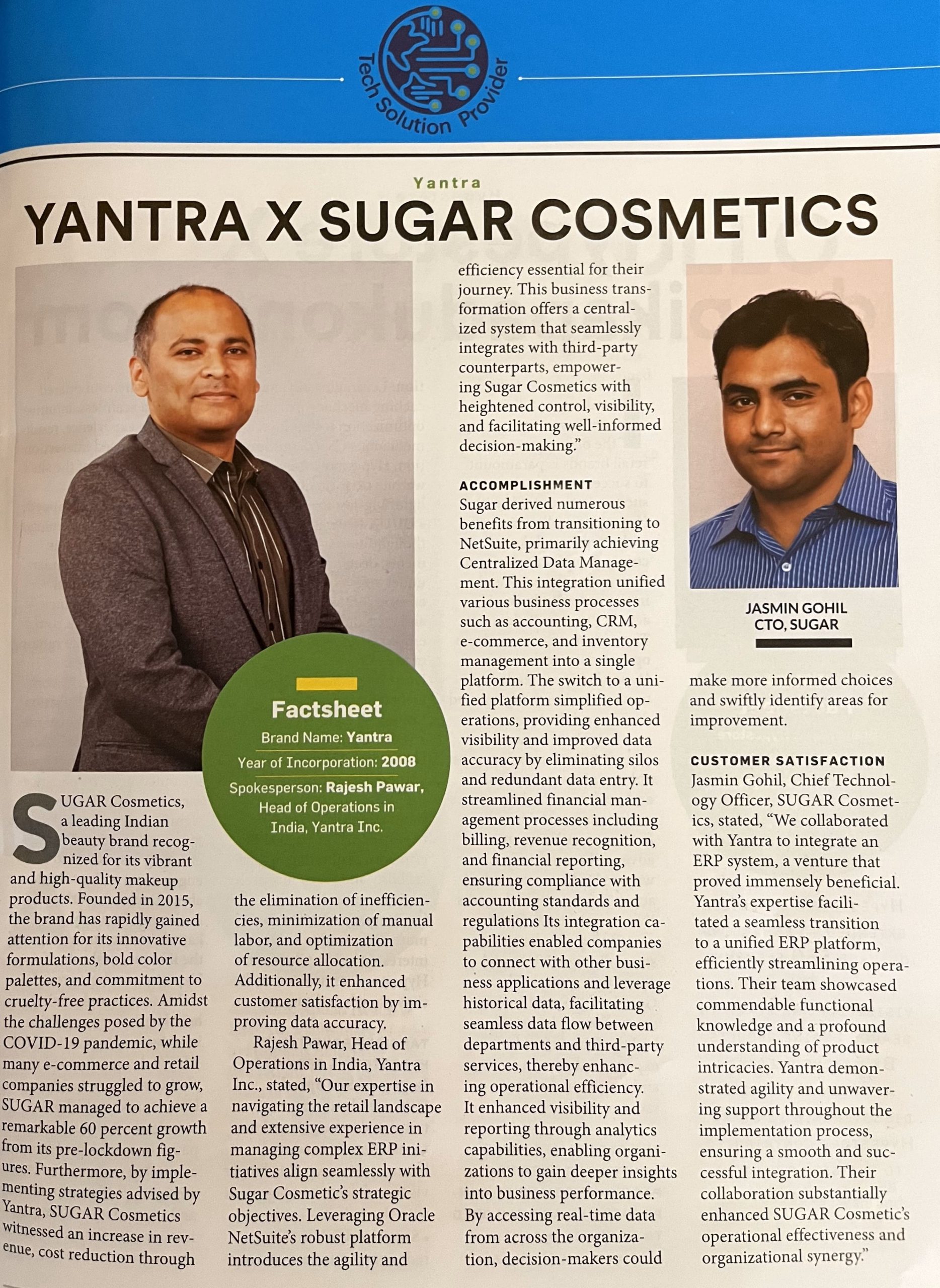Consumer tastes are changing. People are shopping in multiple channels, and they aren’t willing to wait long for their purchases to be delivered. Companies across all sectors are trying to keep up with these shifts while maintaining profitability. The retail fine jewelry industry is no exception. In fact, the customized, personalized nature of their products can make jewelry retailers especially sensitive to shifts in consumer behavior, expectations, and shopping preferences.
As new generations take over companies that have been in the family for sometimes, many decades, they need accurate customer data, operational visibility, and automated support tools rather than, legacy systems, spreadsheets, and manual processes. A new generation of owners is looking to today’s Enterprise Resource Planning (ERP) platforms to help run operations more profitably.
“Many of these [jewelry] companies are flying blind due to a lack of operational visibility. They’re making decisions based on gut feel, with any data-based decisions largely dependent on information that’s being processed through spreadsheets.” Vikram Bhandari, Founder, and CEO, Yantra, Inc.
Staying in Front of Ever-Changing Customer Demands
With a current market size of $61 billion, the US retail jewelry market encompasses nearly 300,000 companies that employ just over 3.3 million people. Specializing in diamond jewelry, watches, gold and fashion jewelry, and pearl and non-diamond gemstone products, the sector is highly fragmented and includes everyone from online sellers to family-owned jewelry stores with one location to very large national retailers.
Like most retail sectors, the fine jewelry industry is working to adapt to ever-changing consumer demands, expectations, and preferences. While most customers still want to try on fine jewelry before making a decision, most of those buyers also want to be able to shop online, interact with stores via smartphones, and use social media to keep up with new styles and trends.
“The whole concept of the buying cycle has changed, and so has the buyer demographic, which now includes, tech-savvy customers,” said Vikram Bhandari, Founder, and CEO at Yantra, a NetSuite Alliance Partner. “This new generation of buyers has different expectations than traditional jewelry buyers do.”
These pressures have created new challenges for retailers:
- Jewelers often create and produce their own designs. This can add time to the final manufacturing process, particularly in light of broader supply chain disruptions and challenges.
- Like many of their retail counterparts, some jewelers are adding an e-commerce presence to complement their brick-and-mortar stores. Others are focused solely on their online sales channels. In most cases, e-commerce is managed with standalone online platforms that don’t sync with back-end and brick-and-mortar operations. This can result in a fragmented sales experience for the consumer.
- To operate their multifaceted operations, most companies rely on a combination of proprietary and homegrown solutions, including Microsoft Value-Added Reseller (VAR) Just Jewelry, Fantasy, Mi9, or a combination of QuickBooks and Fishbowl.
- With no way to share data across retail channels, jewelers are forced to use spreadsheets to gather and share financial and operational reports. This error-prone approach often leads to delays in compiling data into usable, actionable metrics.
“This industry is going through a digital transformation, with most jewelers looking to shift over to a new era of software,” said Rajesh Pawar, director at Yantra. “But cloud-based solutions are not being used universally by jewelry retailers today. Instead, they’re still using homegrown, on-premises tools.”
Because there is no single point of sale (POS) system that fits the needs of all jewelry retailers, these companies are often using multiple disjointed systems to run their operations.
Five Core Functionalities for Growing Jewelry Retailers
With native functionalities like multilocation inventory management, deep supply chain visibility, and two automatic upgrades a year to ensure customers are always on the current release, NetSuite gives multi-channel jewelry retailers the technological foundation they need to grow their businesses.
Here are five core functionalities that NetSuite and Yantra offer fine jewelry retailers:
- Tracking, reporting, and management of global transactions. NetSuite’s multi-subsidiary, multilocation, and multi-entity accounting capabilities help retailers manage stock across various locations, including owned inventory, consignment inventory, and jewelry that’s been received for repair. These are important functions for jewelry stores, where each location operates as its own legal entity. When an intercompany transfer of inventory happens, NetSuite can readily track and report on it.
- Robust inventory management. Jewelry companies also need inventory management systems that can readily catalog, track, and record the sale of their consigned goods. NetSuite manages and tracks this “memo” consigned inventory, eliminating the need for spreadsheets, emails, and follow-up phone calls to determine the status.
- Serial-number tracking of finished goods. NetSuite also manages serial-number tracking on finished goods, stones, and settings as well as buying, tracking, and selling items like watches that also carry serial numbers. Using integration with a gemstone certification agency like GIA (Gemological Institute of America), NetSuite maintains and tracks specific gemstone attributes and stone certification numbers. For stones that require an engraving or a particular setting, Yantra can build an integration to a configurator like NetSuite Configure Price Quote (previously known as Verenia) or Configure One.
- Easy management of variations and fluctuations. Jewelry pieces are often customized according to the specifications of the jeweler or the customer. A company may order 125 rings, for example, and each of those units may have a weight fluctuation of .02 grams or a diamond size that differs by .02 carats. Knowing that gem prices may fluctuate from day to day, Yantra built a custom solution. If the jeweler releases an order for 500 units and receives those units in five lots of 100, then each of those units is entered into the ERP at a separate price. The customization computes the price on a real-time basis using the receipt barcode and the actual weight to calculate variances.
- Automatic purchase order release and work order generation. Yantra also developed a customization that allows jewelry companies to automatically release a PO for each component of a ring, bracelet, necklace, or another piece of jewelry that requires more than one manufacturer.
“As the components come together, they’re assembled within NetSuite as a work order,” Pawar said. “Then, the sales order is filled in and moved over to the merchant request. This value chain is slightly different than that of a traditional manufacturing setup, so we came up with a customization to support it.”
This customization provides substantial value for jewelry companies, many of which offer their customers personalized or custom design options online. For example, the customer will choose the design, metal, precious stone, and/or engravings that will be used to create a custom unit. From a manufacturing and assembly point of view, that unit — which may be sourced across multiple vendors — would require a unique SKU.
Managing Repairs and Warranties
Jewelers also need an easy way to manage repair or warranty work. This requires careful orchestration as pieces are received, sent out for repair, and returned to the customer. Retailers need to have good visibility into total repair costs and whether those fees exceed the cost of the piece. Finally, they need to know exactly which items on a bill of sale are or aren’t eligible for a specific warranty.
Managing all of this on spreadsheets and disconnected software systems is time-consuming, labor-intensive, and error-prone. For the consumer who brings in a gold chain for repair and then buys two more of a similar product the same day, for example, the retailer needs to know which warranty applies to each necklace.
To help jewelers keep track, Yantra integrates the existing POS with NetSuite. The ERP “tags out” the three SKUs that the buyer purchased and shows which one has the warranty.
“That way, when someone pulls up that record on POS, they see that, yes, this is the ring that had the warranty,” said Bhandari. “It’s the combination of NetSuite and a POS that makes that happen.”
Using NetSuite as a foundation, Yantra also helps jewelry retailers automate key processes:
- Trade-ins: Customers can bring their jewelry to trade in and have the value applied to the new item they’re buying, such as a larger diamond in a wedding ring. Retailers must track this inventory, offer in-house credit programs, and manage these transactions.
- Sales commission tracking: Retailers can split commissions by order or by item, since multiple salespeople may be working with the same customer to earn the respective commission on each item sold.
- Gold revaluation: The gold market is always in flux, and owners often want to revalue and/or resell the gold they own. Yantra’s customizations account for this commodity rate fluctuation and allow retailers to use NetSuite to manage the revaluation process.
With a typical implementation time of six to eight months, Yantra brings all processes — from the time an order is placed until it’s handed to the end customer — onto a single platform.
Knowing that every jewelry retailer is unique, Yantra enhances NetSuite’s native functionalities by adding customizations that customers use to automate their processes, simplify their operations, and gain higher levels of operational visibility.



